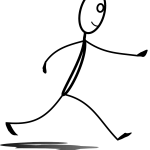We’ve all seen athletes be they on the running track or a football pitch with various pieces of brightly coloured tape on their bodies. The tape is likely to be kinesiology tape and whilst it really first came on the scene at the 1988 Seoul Olympics, though it has been around since the 1970’s, and it really gained a lot of exposure at the 2008 Beijing games. I must admit I came a bit late to the use of Kinesiology tape though I had read quite a few articles around it’s use and the perceived benefits within a treatment protocol. I have to say I was a bit skeptical about it but it was definitely on my to do list with regards to finding out more about it. Earlier this year I went on one of Rocktape’s courses after reading a lot of good things about their courses in comparison to others with regards to the content and their approach and I have to say I wasn’t disappointed as the course was indeed very good covering a lot of the research on the tape, it’s effects and why it may work. This was great as they discounted many of the more outlandish claims and reasons why it may work. Rocktape aren’t afraid to acknowledge the limitations of what taping can do, Andy Caldwell, the instructor on the course was very clear about it being a tool that can aid the recovery process and that it’s use did not negate the use of standard rehab protocols, nor do they try to hide studies and we were presented with both positive and negative results from various studies and highlighted the limitations of many of the studies whether they were negative or positive in the results.
Since I’ve been using the tape in the clinic I’ve seen some very useful results in the form of symptom/pain reduction. With myself as an example, I have been suffering from quadriceps tendinopathy in my left leg for some time and I tried the tape out on it. The pain was affecting me when I was running and squatting and whilst it didn’t prevent me from doing either it was very annoying. With squatting it would take a good few sets before it felt the pain disappear and the movement feel smooth whilst with running it was just general niggle during and after the run. After the tape was applied I noticed an improvement in movement and the level of discomfort the following workout was reduced and similarly when I was running. I still had to rehab the area but the reduction in pain definitely was a bonus during the first 2-3 weeks as the rehab got a chance to have an affect.
With two different clients I have seen useful results. In one case they were experiencing pain in the plantar fascia and up into the achilles insertion and whilst the taping didn’t seem to reduce the symptoms at rest they were able to run without pain after we applied a spiral line of tape from the foot to the hip. In another client they were experiencing a redction in lateral flexion and rotation to the right through the torso and after the application of tape along the lateral line on the right we saw an improvement in both movements.

